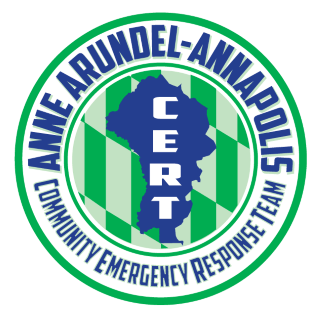On Wednesday, June 19, Anne Arundel-Annapolis Community Emergency Response Team (AAACERT) training featured a presentation on Weather Hazards and Safety by Joseph Seborowski of the Anne Arundel County Office of Emergency Management (OEM). Seborowski, a trained meteorologist, is a Recovery Planner with the OEM.
Mr. Seborowski noted that Maryland’s location between the Atlantic Ocean and the Appalachian Mountains, with the Chesapeake Bay in its midst, means that the state experiences nearly every type of weather phenomenon, including thunderstorms, tornadoes, flooding, tidal/coastal flooding, tropical storms/hurricanes, severe winter weather, enhanced fire threat, and extreme heat and cold. He discussed weather terms and tools, and outlined appropriate safety measures all citizens can take for each potential weather hazard. On its website, the OEM hosts the Citizen’s Guide to Emergencies, a great reference on how to prepare.
Maryland is prone to thunderstorms, he noted. Among the possible terminology weather watchers might encounter (Outlook, Advisory, Watch, and Warning), Seborowski noted that there are also six thunderstorm risk categories, ranging from “slight” to “high”; Maryland’s thunderstorms generally fall within the slight-to-enhanced range. The dangers that can accompany storms include microbursts – “punches” of wind up to 120 m.p.h. from the most intense part of the storm – and non-thunderstorm winds resulting from tight air pressure gradients between strong areas of low and high pressure. In all cases of wind, he noted the importance for safety of securing loose outdoor objects, moving to an interior room, being prepared for outages, and especially treating any downed wires as live and not approaching them.
Lightning is an additional hazard from thunderstorms. Seborowski reminded the group that 98% of lightning casualties occur outside, and that even a pavilion is not considered safe shelter. Lightning can strike up to 10 miles from an area of rain. Seborowski reminded CERT members of the “30/30 Rule”: Count 30 seconds after seeing lightning or hearing thunder – if you hear thunder, you are at risk; and wait 30 minutes after hearing the last rumble of thunder before emerging outdoors.
Flooding is a year-round threat in Maryland. Though it might be tempting to proceed because “you know the road,” never attempt to traverse water covering the road surface. A mere six inches of water can cause the vehicle to lose traction and be swept off of the pavement. Additionally, the road may no longer be there.
Seborowski discussed the difference between tornadoes, funnel clouds, and waterspouts, and reminded CERT team members of basic tornado safety. A tornado is a funnel in contact with the ground, while a funnel that does not touch the ground is not a tornado. A waterspout is a tornado over water. Maryland typically sees three-to-four tornadoes per year, although that number may be increasing. Participants in the SKYWARN program assist weather authorities by reporting what is actually occurring in various locations, as the official radar stations are located in Sterling, Va., Dover, Del., and State College, Pa. As always, the key to tornado safety is to get quickly to a basement or interior room with no windows.
Next, Seborowski explained the difference between a tropical wave, tropical depression, tropical storm, and hurricane – all of which can affect Maryland. A tropical wave occurs when a long area of low pressure moves in an easterly direction across the tropics, potentially creating inclement weather. If winds move in a circular direction at speeds of 38 m.p.h. or slower, a tropical depression exists. A tropical storm is declared at windspeeds of 39 m.p.h. or higher, and a hurricane has wind speeds of 74 m.p.h. or higher. The 2019 Atlantic forecast calls for nine to 15 named storms, and four to eight hurricanes, with two to four of those being major hurricanes. Tropical storm/hurricane safety would seem to be common sense: Know your evacuation zone and evacuation route, have your supplies packed and ready to go, and stay abreast of updates from a reliable source.
The final Maryland weather hazard Seborowski discussed was extreme heat and cold. He directed the CERT learners to the National Oceanic and Atmospheric Administration’s Heat Index Table, as well as the National Weather Service’s Wind Chill Chart for reference. In heat, it is important always not to leave a person or pet in a vehicle, to seek air-conditioning and/or shade where it is available, to wear loose, lightweight clothing, and to remain hydrated. Contrary to some teaching, running a fan in hot temperatures does not cool the body, and consuming high-energy drinks can cause more over-heating. In extreme cold, remain indoors in heat, and remember to check on the elderly and pets. Wear layered, loose-fitting clothes, including – if outdoors – a hat and hand-covering (mittens are better than gloves!). Remember to keep your mouth covered and stay dry. Lastly, monitor your well-being while shoveling snow, as heart attack is common due to the extra stress on the system during that exertion.
Lastly, Seborowski described the three types of radar officials use to predict the weather for a geographic location. Base Reflectivity (BR) measures the type and location of precipitation. However, Base Velocity (BV) radar can tell users the speed of various patches of precipitation and where fronts may be colliding, providing some predictive capability for possible violent weather. The third type of radar is Vertically Integrated Liquid (VIL), which measures the total amount of water vapor in a column of air (and can be a good gauge of hail activity).
Seborowski shared many additional facts, and AAACERT learners got good answers to their many questions. Thanks to his thorough presentation, the team is now better informed about Maryland’s particular weather hazards and how to avoid the accompanying dangers those conditions might bring.
Photo: Potential tropical cyclones in 2019 are named by weather officials; Andrea has already passed. (Slide Source: J. Seborowski, AAOEM)
